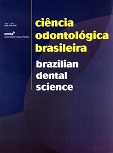Efeito da ativação química ou dual na microdureza knoop de cimentos resinosos
DOI:
https://doi.org/10.14295/bds.2008.v11i4.674Abstract
O presente trabalho avaliou a microdureza Knoop de três cimentos resinosos comerciais de dupla ativação quando polimerizados a partir da ativação química ou da dupla ativação. Os cimentos de resina avaliados foram: Rely X Arc (3M ESPE), Bistite II DC (Tokuyama) e Fill Magic Dual Dement (Vigodent). Os corpos-de-prova foram confeccionados em matrizes metálicas com 7 mm de diâmetro interno e 1 mm de espessura. Os materiais foram manipulados segundo recomendações do fabricante e inseridos na matriz metálica e, posteriormente divididos em dois grupos com seis espécimes cada: G1 – o cimento foi fotoativado por 40 segundos e armazenado em recipiente escuro; G2 – espécimes mantidos em recipiente escuro após a manipulação. Após 24±1 hora, o ensaio de microdureza Knoop foi realizado e os dados submetidos à análise de variância e teste de Tukey (5%). Os resultados mostraram que o cimento Rely X ARC não apresentou diferença estatística entre os grupos de ativação química ou dual, bem como obteve os maiores valores de microdureza, comparativamente aos demais materiais testados. O cimento Bistite II DC demonstrou valores superiores no grupo de ativação química, enquanto o Dual Cement não polimerizou somente com a ativação química, porém mostrou valores de microdureza intermediária para o grupo de dupla polimerização. Desta forma é possível concluir que há diferenças no comportamento de polimerização entre cimentos resinosos comercializados como sendo de dupla polimerização.
Downloads
Downloads
Published
How to Cite
Issue
Section
License
Brazilian Dental Science uses the Creative Commons (CC-BY 4.0) license, thus preserving the integrity of articles in an open access environment. The journal allows the author to retain publishing rights without restrictions.
=================




























